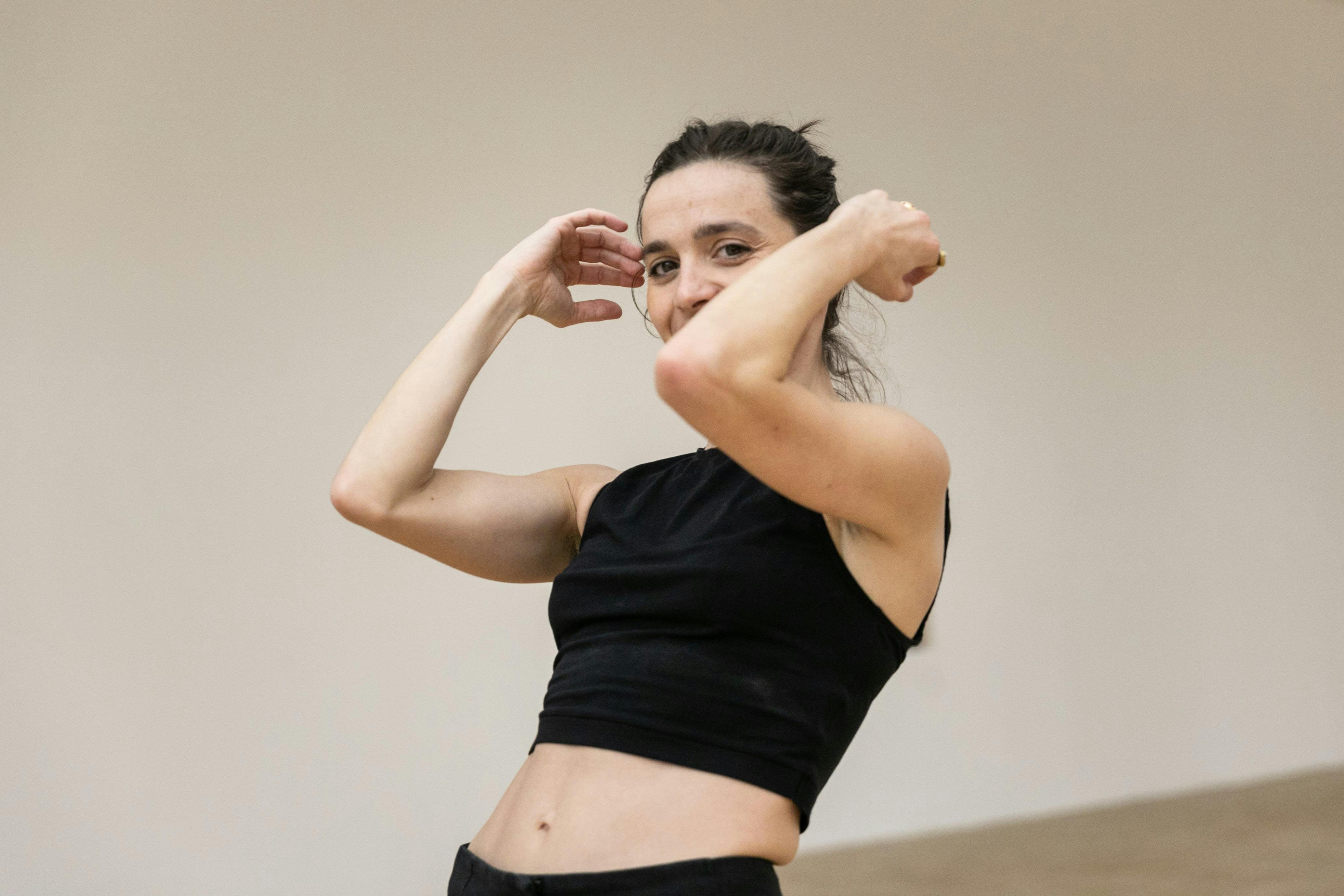

Annamaria Ajmone, photo by Gianluca di Ioia
For Triennale Decameron, the choreographer and dancer Annamaria Ajmone presents a performance, as part of a larger project, called Arcipelago. Arcipelago is a collection of “temporary stays”, with each action transforming the space into a private but shared “place”. We put a few questions to Annamaria to find out more about the new performance she has created to interact with the geometries of the spaces at Triennale.
What does representing a landscape mean to you?
I wouldn’t talk of representation, but rather of a co-creation of environments. The word “represent” sounds to me rather two-dimensional and passive, whereas I view dance as an experience that the audience enters into together with the performer. An experience that has to do with perceptions – with temperature, smell, and vibration. We co-inhabit a space and a time, and we share responsibilities.

Annamaria Ajmone, photo by Gianluca di Ioia
How does the creation of your site-specific choreography come about?
The approach changes depending on the subject or object I’m going to encounter – which may be open or closed, inhabited or uninhabited, and so on. I like to imagine these searches as transitions, encounters, and clashes. I make choices, which are suggested to me by the space in question, by the elements that I decide to bring into play, by my own vision and, subsequently, by that of the public. The body, both mine and that of the public (are they keeping still? are they moving? where and how? what is their point of view? is it changing?), and the sound sources, both natural and musical, are made to interact with the space, guiding the performance, while the time spent in the space opens up other possibilities and forms. It’s a sort of pact between the performer and the spectators: for a certain length of time, we turn the space into a unique, other place. The elements involved in the work for Triennale Decameron were dance, architecture, and cinema. Once we had chosen the space, we decided on the framing, so I had the precise point of view, and I knew it would be a sequence shot, that there would be no camera movement, and that the format would be vertical. We decided not to use music, but we did keep the sound of the space. I built up the dance on the basis of all these elements. Dance creates a shift of volumes with respect to a given structure, and it takes shape together with all of the elements involved. When I ran the video again, as soon as the live broadcast was over, I could hear not just my breathing and my verses, which were very loud due to the reverberation, but also the operator’s breathing and movements. It was quite amazing, and totally unexpected – I loved those unforeseen presences. Spaces are never empty, for there’s always a legacy.

Annamaria Ajmone, photo by Gianluca di Ioia
Where do you get your inspiration from for your work? For example, your latest work, called NO RAMA, speaks of “a place geographically close to our own, not far and not impossible, but with frequent incursions of an elsewhere that is equally future, present, and subterranean...”
Each work already contains the seeds of the next; there’s always something you put aside and that then returns, even if only in the form of rejection. The rest are coincidences, encounters, stumbles, and dreams. NO RAMA is an artistic research that took in a variety of sensitivities and visions – my own, but also those of Marta Capaccioli, Lucrezia Palandri, Francesco Cavaliere, Jules Goldsmith, and Giulia Pastore. My interaction with the Industria Indipendente company has also been fundamental: I’ve been following an infinite project with them, called A t t i k a, and we are currently preparing Klub Taiga (due to premiere, if possible, in July 2020 at the Theatre section of the Venice Biennale), which winds its way through the same chinks and hallucinations. NO RAMA is a richly imaginative reflection on the future of our planet. It contains an intermingling of many works of speculative fiction and science fiction, as well as scientific theories, political ecology, ethnographic essays, and a variety of articles and visions. NO RAMA talks to us of alliances and biodiversity, of multi-species, aliens. and new words. It looks not just at the human, but also at the extra-human, at the natural and the anti-natural, with the awareness of the responsibilities we all have to create new spaces for the imagination, and for revolt and resistance.

Annamaria Ajmone, photo by Gianluca di Ioia
Annamaria Ajmone is a dancer and choreographer. Her artistic research focuses on the body, which she views as a pliable, ever-changing material that can transform spaces into places by creating temporal superimpositions and parallels. She has presented her works in numerous festivals, museums, art galleries and atypical spaces in Europe, Asia, North Africa and the United States. In 2015 she won the Danza&Danza 2015 Award for Best Emerging-Contemporary Performer. She is an associate artist with Triennale Milano Teatro for the three-year period 2019/2021.
Related events
